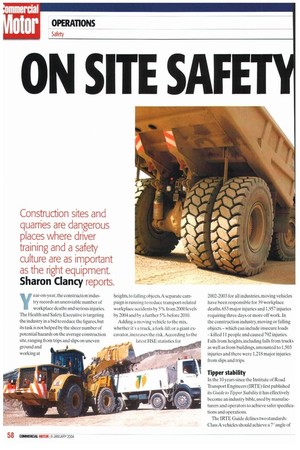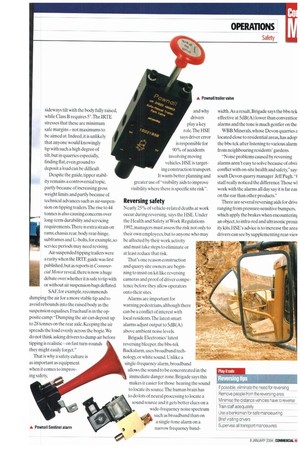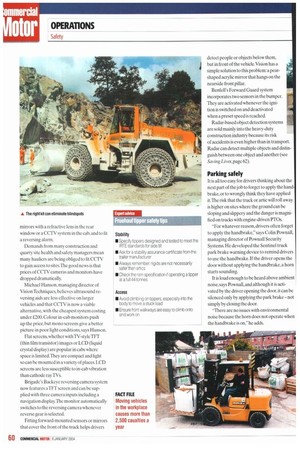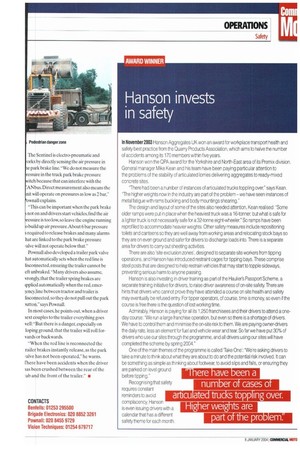ON SITE SAFE
Page 58

Page 59

Page 60

Page 61

If you've noticed an error in this article please click here to report it so we can fix it.
Construction sites and
quarries are dangerous
places where driver training and a safety
culture are as important
as the right equipment.
Sharon Clancy reports.
If ear-on-year, the construction indus
try records an unenviable number of workplace deaths and serious injuries. The Health and Safety Executive is targeting the industry in a bid to reduce the figures, but its task is not helped by the sheer number of potential hazards on the average construction site, ranging from trips and slips on uneven ground and working at heights, to falling objects. A separate campaign is running to reduce transport-related workplace accidents by 5`)/0 from 2000 levels by 2004 and by a further 5% before 2010.
Adding a moving vehicle to the mix, whether its a truck, a fork-lift or a giant excavator, increases the risk. According to the latest USE statistics for 2002-2003 for all industries, moving vehicles have been responsible for 39 workplace deaths, 653 major injuries and 1,957 injuries requiring three days or more off work. In the construction industry, moving or falling objects — which can include insecure loads — killed 11 people and caused 792 injuries. Falls from heights, including falls from trucks as well as from buildings, amounted to 1,503 injuries and there were 1,218 major injuries from slips and trips.
Tipper stability In the 10 years since the Institute of Road Transport Engineers (IRTE) first published its Guide to Tipper Stability it has effectively become an industry bible, used by manufacturers and operators to achieve safer specifications and operations.
The IRTE Guide defines two standards: Class A vehicles should achieve a 7 angle of
sideways tilt with the body fully raised, while Class B requires 5°.The IRTE stresses that these are minimum safe marginsnot maximums to be aimed at. Indeed, it is unlikely that anyone would knowingly tip with such a high degree of tilt. but in quarries especially, finding flat,even ground to deposit a load can be difficult.
Despite the guide, tipper stabil ity remains a controversial topic, partly because of increasing gross weight limits and partly because of technical advances such as air-suspen sion on tipping trailers:The rise to 44 tonnes is also causing concerns over long-term durability and servicing requirements.There is extra strain on rams, chassis rear. body rear-hinge. subframes and U-bolts, for example,so service periods may need revising.
Air-suspended tipping trailers were a rarity when the IRTE guide was first published, but as reports in Commercial Motor reveal, there is now a huge debate over whether it is safe to tip with or without air suspension bap deflated.
SAE for example. recommends dumping the air for a more stable tip and to avoid rebounds into the raised body as the suspension equalises. Fruehauf is in the opposite cam p:"Dumping the air can deposit up to 28 tonnes on the rear axle. Keeping the air spreads the load evenly across the bogie.We do not think asking drivers to dump air before tipping is realistic on fast turn-rounds they might easily forget."
That is why a safety culture is as important as equipment when it comes to improving safety, and why drivers play a key role.The HSE says driver error is responsible for 90% of accidents involving moving vehicles. HSE is targeting construction transport.
It wants better planning and greater use of "visibility aids to improve visibility where there is specific site risk".
Reversing safety Nearly 25% of vehicle-related deaths at work occur during reversing, says the HSE. Under the Health and Safety at Work Regulations 1992, managers must assess the risk not only to their own employees, but to anyone who may be affected by their work activity and must take steps to eliminate or at least reduce that risk.
That's one reason construction and quarry site owners are beginning to insist on kit like reversing cameras and proof of driver competence before they allow operators onto their sites.
Alarms are important for warning pedestrians, although there can be a conflict of interest with local resident&The latest smart alarms adjust output to 5dB(A) above ambient noise levels.
Brigade Electronics' latest reversing bleeper. the bbs-tek Backalarm. uses broadband technology, or white sound. Unlike a single-frequency alarm. broadband allows the sound to be concentrated in the immediate danger zone. Brigade says this makes it easier for those hearing the sound to locate its source.The human brain has to do lots of neural processing to locate a sound source and it gets better clues on a wide-frequency noise spectrum 0 such as broadband than on a single-tone alarm on a narrow frequency band width. As a result. Brigade says the bbs-tek effective at 5dB(A) lower than convention alarms and the tone is much gentler on the Wl3B Minerals. whose Devon quarries a located close to residential areas,has adopi the bbs-tek after listening to various alarm from neighbouring residents' gardens.
"Noise problems caused by reversing alarms aren't easy to solve because of obvii conflict with on-site health and safety," say; south Devon quarry manager Jeff Pugh."( staff really noticed the difference.'Those wl work with the alarms all day say it is far eas on the ear than other products."
There are several reversing aids for drivt ranging from pressure-sensitive bumpers, which apply the brakes when encounterint an object, to infra-red and ultrasonic proxii ity kits. HSE's advice is to increase the area drivers can see by supplementing rear-viev mirrors with a refractive lens in the rear window or a CCTV system in the cab. and to lit a reversing alarm.
Demands from many construction and quarry site health and safety managers mean many hauliers are being obliged to fit CCTV to gain access to sites.The good news is that prices of CCTV cameras and monitors have dropped dramatically.
Michael Hanson. managing director of Vision Techniques, believes ultrasound reversing aids are less effective on larger vehicles and that CCTV is now a viable alternative, with the cheapest system costing under £200. Colour in-cab monitors push up the price. but mono screens give a better picture in poor light conditions, says Hanson.
Flat screens,whether withTV-style TFT (thin film transistor) images or LCD (liquid crystal display) are popular in cabs where space is limited.They are compact and light so can he mounted in a variety of places. LCD screens are less susceptible to in-cab vibration than cathode ray TVs.
Brigade's Backeye reversing camera system now features a TFT screen and can be supplied with three camera inputs including a navigation display.The monitor automatically switches to the reversing camera whenever reverse gear is selected.
Fitting forward-mounted sensors or mirrors that cover the front of the truck helps drivers detect people or objects below them, but in front of the vehicle.Vision has a simple solution to this problem a pearshaped acrylic mirror that hangs on the nearside front pillar.
Benfell's Forward Guard system incorporates two sensors in the bumper. They are activated whenever the ignition is switched on and deactivated when a preset speed is reached.
Radar-based object detection systems are sold mainly into the heavy-duty construction industry because its risk of accidents is even higher than in transport. Radar can detect multiple objects and distinguish between one object and another (see Saving Lives, page 62).
Parking safely
It is all too easy for drivers thinking about the next part of the job to forget to apply the hand brake,or to wrongly think they have applied it.'The risk that the truck or artic will roll away is higher on sites where the ground can be sloping and slippery and the danger is magnified on trucks with engine-driven PT0s.
"For whatever reason, drivers often forget to apply the handbrake," says Cohn Pownall, managing director of Pownall Security Systems. He developed the Sentinel truck park brake warning device to remind drivers to use the handbrake. If the driver opens the door without applying the handbrake, a horn starts sounding.
It is loud enough to be heard above ambient noise, says Pownall, and although it is activated by the driver opening the door, it can be silenced only by applying the park brake—not simply by closing the door.
"There are no issues with environmental noise because the horn does not operate when the handbrake is on." he adds. 'Ihe Sentinel is clectro-pneumatic and orks by directly sensing the air pressure in e park brake line. "We do not measure the ressure in the truck park brake pressure 'tch because that can interfere with the ANbus. Direct measurement also means the nit will operate on pressures as low as 2 bar," ownall explains.
"This can be important when the park brake not on and driven start vehicles, find the air ressure is too low, so leave the engine running build up air pressure. About 6 bar pressure s required to release brakes and many alarms hat are linked to the park brake pressure /alve will not operate below that."
Pownall also developed a trailer park valve hat automatically sets when the red line is lisconnected. ensuring the trailer cannot be eft unbraked.-Many drivers also assume, vrongly, that the trailer spring brakes are ipplied automatically when the red, emer;ency, line between tractor and trailer is lisconnected, so they do not pull out the park )utton," says Pownall.
In most cases. he points out, when a driver iext couples to the trailer everything goes ve1l:"13ut there is a danger, especially on loping ground, that the trailer will roil foryards or backwards.
"When the red line is reconnected the railer brakes instantly release, as the park falve has not been operated,he warns. ['here have been accidents when the driver las been crushed between the rear of the :ab and the front of the trailer." •
















































































































































































